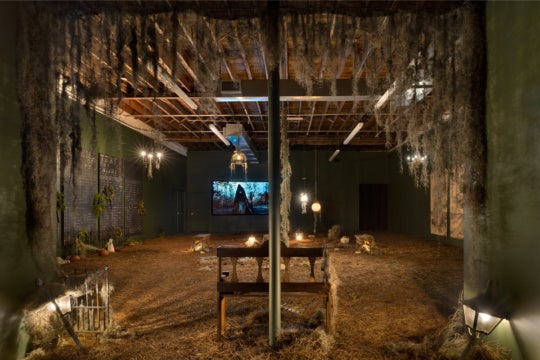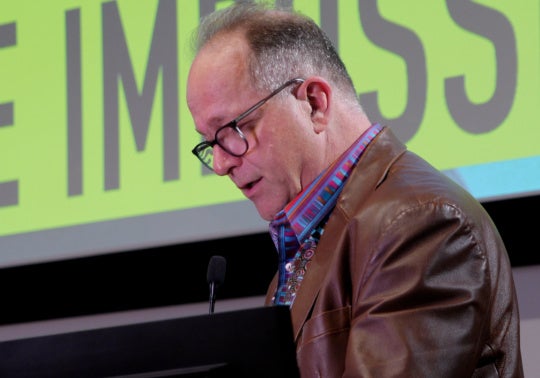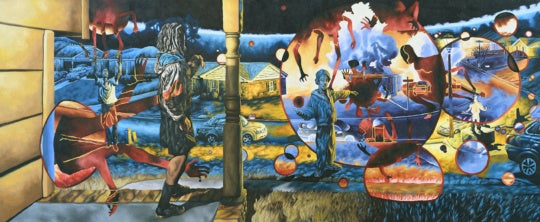
On a recent trip to Los Angeles, I was able to see some of Pacific Standard Time: Art in L.A. 1945-1980, a cross-institutional series of exhibitions celebrating the history of contemporary art in L.A. The brainchild of the Getty Foundation, the six-month event is composed of 68 museum exhibitions and over 70 galleries featuring more than 1,300 artists. As I wandered the rooms at the Getty Museum admiring Judy Chicago’s Car Hood and Ed Ruscha’s The Los Angeles County Museum on Fire, I wondered if this sort of collaboration could happen in Atlanta.
The exhibitions comprising Pacific Standard Time delve into broad themes including politics and music. Exhibits such as Trouble in Paradise: Music and Los Angeles, 1945-1975 at The GRAMMY Museum were broad in theme but still thoughtful in execution. Others were extremely focused, such as From Start to Finish: De Wain Valentine’s Gray Column, a single-room show at the Getty that explains the creation and conservation of the artwork. Several of the shows deal with issues of race and gender in the postwar period, giving focus to the conditions of minority artists and architects and the contributions they made.
The art is fantastic, and the exhibitions are well thought-out. The only thing more impressive is the effort put into organizing such an expansive region-wide collaboration. Planning for Pacific Standard Time began a decade ago, and its realization has been a truly collaborative exchange of resources and permanent collections between the Getty and participating institutions.
As someone invested in the Atlanta art scene, Pacific Standard Time seems to stand as a challenge. In her review for The New York Times, Roberta Smith writes that a message to take away from Pacific Standard Time is “that New York did not act alone in the postwar era.” It seems everywhere that isn’t New York is burdened with the knowledge that New York is the center and apex of art. If Pacific Standard Time successfully challenges that, what does it mean for other art-making regions, and how are they supposed to respond?
I posed this question to James Meyer, associate curator of modern and contemporary art at the National Gallery of Art and former associate professor of art history at Emory University. He replied via email, “Pacific Standard Time indeed poses questions for other areas of the United States. Southern California stands out as the other major art scene [second to New York], though by no means the only one. Atlanta is far behind other cities, much less L.A., for historical reasons that are well known. Dallas, Houston, Miami, and Chicago are much more interesting.”
“There is a lack of civic will or vision,” Meyer continued. “The city leadership allowed the only local art school, ACA [Atlanta College of Art], with a respectable 100-year history, to fold. The facilities were handed over to the for-profit SCAD [Savannah College of Art and Design] without a fight. Emory is unwilling to support a serious studio program. A city needs to invest in culture for culture to flourish. Atlanta understands music. But not art.”

Meyer’s list of weaknesses in Atlanta’s art scene is a familiar one, with certain truths behind it. Indeed, in her review Smith cites the influential art schools in Los Angeles as a major factor in the expansive growth of the postwar years. By contrast, SCAD is often regarded as a ruthless upstart, enacting manifest destiny in the state of Georgia.
SCAD does bring resources to the area, however, with its galleries and labs as well as exciting faculty and a decent population of new art students. In that regard, SCAD still has to prove its longevity and ability to grow in ways that sustain dedicated artistic practice in the area.
The greater discussion on Atlanta’s weaknesses often centers on conservatism surrounding the High Museum, mainly the lack of institutional support beyond it and its focus on blockbusters rather than groundbreaking exhibitions.
The recent Radcliffe Bailey retrospective (click here for BURNAWAY’s review), however, drew effusive praise for showcasing an Atlanta artist, and the High’s partnership with the Museum of Contemporary Art of Georgia (MOCA GA) for the series Trading Places is also a step in the right direction. And in case it hasn’t been said enough, WonderRoot, Possible Futures, Idea Capital, and other arts advocates are a crucial shot in the arm for Atlanta arts.
Not everyone is pessimistic about Atlanta’s place in American art. In a recent conversation with art critic Catherine Fox on the subject of Noplaceness: Art in a Post-Urban Landscape, the first book in the Atlanta Art Now series, she brought up Pacific Standard Time. “I was in L.A. and went to see Pacific Standard Time,” Fox said, “and, as I was walking through the MOCA, I thought to myself, we [the writers of Noplaceness] are doing the fieldwork for the historians of the future. It was interesting to me that a lot of the issues were similar, and the way [the artists] were responding to their environment made it a distinct body of work as diverse as they were.”
Fox continued, “I think we could do a show like that now. I think there’s plenty to write about and a story to tell.”
I posed the same question to Joey Orr, a founding member of the local collective John Q and graduate student at Emory University (click here for BURNAWAY’s interview). His response was thoughtful, but he didn’t embrace the idea. “While I’ve certainly enjoyed some of the short films produced by Pacific Standard Time,” he said, “it’s always interesting to feel what kinds of vibes a place wants to cultivate, especially when they become city-wide campaigns. These kinds of things can be motivated by many different agendas, though not necessarily all instrumental, of course …. I’d hate to see Atlanta take a defensive stance, though, as if it needs to explain or defend its particular scenes or ways of exchange. Or, for that matter, merely step into a pre-existing formula.”
Is the South ready for a regional retrospective? What would that look like? Would the history of contemporary art in the South start with the Civil Rights Movement, or should it be some other milestone? What should appear on a timeline of influential exhibitions and art movements from the South?
Pacific Standard Time: Could Atlanta Adapt Los Angeles's Model?
Related Stories
Call For Artists
BA x Oxford American
Studio Visit
Call for Artists: July 2025
Our monthly round of opportunities includes a resident artist program for craft artists in Penland, a residency in Knoxville, and an open call for installation-based solo exhibitions in Miami,
Inside Rice University’s 2025 UFO Conference
In June's co-publishing partnership with Oxford American, UFO enthusiast and author Will Clarke goes behind the scenes at Rice University’s 2025 Archives of the Impossible Conference in Houston, Texas.
In the Studio with Tim Short
Tyra Douyon visits the studio of Tim Short, a narrative painter based in Stone Mountain, Georgia, to speak on the imaginative and metaphysical iconography tied to Blackness.




